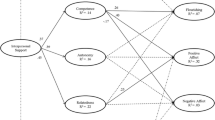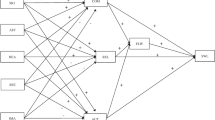Abstract
The present study sought to examine the role of social support and group cohesion in the compliance behavior of females required to exercise for health-related reasons. Compliance behavior was assessed as attendance and dropout behavior. Participants (N = 49) drawn from a clinical exercise group completed questionnaires to assess cohesion and social support. Discriminant function analyses were able to discriminate between high and low attenders as well as between dropouts and graduates. Participants reporting high scores on the support provision of reliable alliance and the cohesion factor of ATG-Task, along with low scores on the social support provision of guidance, were more likely to attend a higher proportion of classes. For dropouts, participants with higher scores on the support provision of reliable alliance were less likely to drop out. As a secondary objective, it was found that cohesion and social support variables both contributed to the successful prediction of attendance.
Similar content being viewed by others
REFERENCES
Blair, S., Kohl, H., Paffenbarger, R., Clark, D., Cooper, K., and Gibbons, L. (1989). Physical fitness and all-cause mortality: A prospective study of healthy men and women. JAMA 262: 2395–2401.
Booth, F. W., Gordon, S. E., Carlson, C. J., and Hamilton, M. T. (2000). Waging war on modern chronic diseases: Primary prevention through exercise biology. J. Appl. Physiol. 88: 774–787.
Brawley, L. R., and Culos-Reed, S. N. (2000). Studying adherence to therapeutic regimens: Overview, theories, recommendations. Controlled Clin. Trials 21: 156S–163S.
Brawley, L. R., and Rodgers, W.M. (1993). Social-psychological aspects of fitness promotion. In Seraganian, P. (ed.), Exercise Psychology: The Influence of Physical Exercise on Psychosocial Processes, JohnWiley & Sons, New York, pp. 254–298.
Carron, A. V., and Spink, K. S. (1993). Team building in an exercise setting. Sport Psychol. 7: 8–18.
Carron, A. V., and Spink, K. S. (1995). The group size/cohesion relationship in minimal groups. Small Group Res. 26: 86–105.
Carron, A. V., Widmeyer, W. N., and Brawley, L. R. (1985). The development of an instrument to assess cohesion in sport teams: The Group Environment Questionnaire. J. Sport Psychol. 7: 244–266.
Centers for Disease Control and Prevention (1997). Resources and priorities for chronic disease prevention and control, 1994. Morbid. Mortal. Week. Rep. 13: 286–287.
Courneya, K. S., and McAuley, E. (1995a). Cognitive mediators of the social influence–exercise adherence relationship: A test of the theory of planned behavior. J. Behav. Med. 18: 499–515.
Courneya, K. S., and McAuley, E. (1995b). Reliability and discriminant validity of subjective norm, social support, and cohesion in an exercise setting. J. Sport Exerc. Psychol. 17: 325–337.
Cronbach, L. J. (1951). Coefficient alpha and internal structure tests. Psychometrika 2: 135–138.
Cutrona, C. E., and Russell, D.W. (1987). The provisions of social relationships and adaptation to stress. In Jones, W. H., and Perlman, D. (eds.), Advances in Personal Relationships, Vol. 1, JAI Press, Greenwich, CT, pp. 37–67.
Dishman, R. K. (1988). Exercise Adherence, Human Kinetics, Champaign, IL.
Duncan, T. E., and McAuley, E. (1993). Social support and efficacy cognitions in exercise adherence: A latent growth curve analysis. J. Behav. Med. 16: 199–218.
Duncan, T. E., and Stoolmiller, M. (1993). Modeling social and psychological determinants of exercise behaviors via structural equations systems. Res. Q. Exerc. Sport 64: 1–16.
Duncan, T. E., McAuley, E., Stoolmiller, M., and Duncan, S. (1993a). Serial fluctuations in exercise behavior as a function of social support and efficacy cognitions. J. Appl. Sport Psychol. 23: 1498–1522.
Duncan, T. E., Duncan, S. C., and McAuley, E. (1993b). The role of domain and gender-specific provisions of social relations in adherence to a prescribed exercise regimen. J. Sport Exerc. Psychol. 15: 220–231.
Ettinger, W. H., Burns, R., Messier, S. P., Applegate, W., Rejeski, W. J., Morgan, T., Shumaker, S., Berry, M. J., O'Toole, M., Monu, J., and Craven, T. (1997). A randomized trial comparing aerobic exercise and resistance exercise with a health education program in older adults with knee osteoarthritis. JAMA 277: 25–31.
Kirschenbaum, D. S. (1992). Elements of effective weight control programs: Implications for exercise and sport psychology. J. Appl. Sport Psychol. 4: 77–93.
Krause, N., Goldenhar, L., Liang, J., Jay, G., and Maeda, D. (1993). Stress and exercise among the Japanese elderly. Soc. Sci. Med. 36: 1429–1441.
Licht,M. H. (1995). Multiple regression and correlation. In L. G., Grimm, and Yarnold, P. R. (eds.), Reading and Understanding Multivariate Statistics, American Psychological Association, Washington, DC, pp. 19–64.
McKay, R. J., and Campbell, N. A. (1982). Variable selection techniques in discriminant analysis I. Description. Br. J. Math. Stat. Psychol. 35: 1–29.
Meichenbaum, D., and Turk, D. C. (1987). Facilitating Treatment Adherence: A Practitioner's Guidebook, Plenum Press, New York.
Morgan, W. P., and Goldston, S. E. (1987). Exercise and Mental Health, Hemisphere, Washington, DC.
Neiman, D. C. (1998). The Exercise-Health Connection, Human Kinetics, Champaign, IL.
Nunnally, J. C. (1978). Psychometric Theory, 2nd ed., McGraw–Hill, New York.
O'Brian Cousins, S. (1995). Social support for exercise among elderly women in Canada. Health Promot. Int. 10: 273–282.
Oka, R. K., King, A. C., and Young, D. R. (1995). Social support as predictors of exercise adherence in women and men ages 50 to 65. Women's Health 1: 161–175.
Oldridge, N. B., and Stoedefalke, K. G. (1984). Compliance and motivation in cardiac exercise programs. Clin. Sports Med. 3: 443–454.
Oman, R. F., and Duncan, T. E. (1995). Women and exercise: An investigation of the roles of social support, self-efficacy, and hardiness. Med. Exerc. Nutr. Health 4: 306–315.
Petruzzello, S. J., Landers, D. M., Hatfield, B. D., Kubitz, K. A., and Salazar, W. (1991). A meta-analysis on the anxiety reducing effects of acute and chronic exercise: Outcomes and mechanisms. Sports Med. 11: 143–182.
Shephard, R. J., Corey, P., and Kavanagh, T. (1981). Exercise compliance and the prevention of a recurrence of myocardial infarction. Med. Sci. Sports Exerc. 13: 1–5.
Silva, A. P. D., and Stam, A. (1995). Discriminant analysis. In Grimm, L. G., and Yarnold, P. R. (eds.), Reading and Understanding Multivariate Statistics, American Psychological Association, Washington, DC, pp. 277–318.
Sorensen, M., Anderssen, S., Hjerman, I., Holme, I., and Ursin, H. (1999). The effect of exercise and diet on mental health and quality of life in middle-aged individuals with elevated risk factors for cardiovascular disease. J. Sports Sci. 17: 369–377.
Spink, K. S., and Carron, A. V. (1992). Group cohesion and adherence in exercise classes. J. Sport Exerc. Psychol. 14: 78–96.
Spink, K. S., and Carron, A. V. (1993). The effects of team building on the adherence patterns of female exercise participants. J. Sport Exerc. Psychol. 15: 39–49.
Spink, K. S., and Carron, A. V. (1994). Group cohesion effects in exercise classes. Small Group Res. 25: 26–42.
Steers, R. M., and Rhodes, S. R. (1978). Main influences on employee attendance: A process model. J. Appl. Psychol. 63: 391–407.
Weiss, R. (1974). The provisions of social relationships. In Rubin, Z. (ed.), Doing unto Others, Prentice Hall, Englewood Cliffs, NJ, pp. 17–26.
Widmeyer, W. N., Brawley, L. R., and Carron, A. V. (1985). The Measurement of Cohesion in Sport Teams: The Group Environment Questionnaire, Sports Dynamics, London, ON, Canada.
Author information
Authors and Affiliations
Corresponding author
Rights and permissions
About this article
Cite this article
Fraser, S.N., Spink, K.S. Examining the Role of Social Support and Group Cohesion in Exercise Compliance. J Behav Med 25, 233–249 (2002). https://doi.org/10.1023/A:1015328627304
Issue Date:
DOI: https://doi.org/10.1023/A:1015328627304




